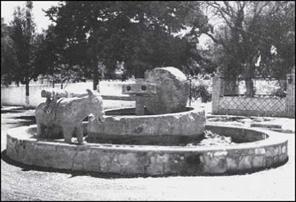In the edge mill, which had been developed in China in about 200 ad, a stone or concrete disk rotated on a stone base. The ancient edge mill is still used in many communities:
In 1975 people in Antakya dried and ground their wheat in September for winter.
This was done in meydans (village squares). An old mill was in the center of the meydan in my ward, its wheel was made from one piece of granite and was about 2 m diameter and 0.5 m wide, and the grinding surface on which the wheel rotated was marble. (Ekmecki 2003)
Edge mills will probably always be used for grinding grains in remote villages where electricity is expensive and water wheels do not exist.
|
|
FIGURE 6.6 Monument to an arrastra with a tahona
During the 19th century the stone rollers used in the ancient edge mills were replaced by iron or steel rollers. This form of edge roller mill, which is shown in Figure 6.7, became known as the “Chilean mill.” It could be operated at low or high speeds (see Table 6.1).
By 1900, the demand for grinding coal, cement clinker, and fertilizers in dry mills was increasing, and this presented an opportunity to the owners of small engineering workshops to build better mills. In 1906, two owners, Curt von Grueber in Berlin and Claudius Peters in Hamburg, visited the United States to look at grinding mills. They both returned to Germany with licenses to build mills—the Maxecon mill by von Grueber and the Fuller mill by Peters. Both men had the vision and tenacity to convert their ideas into large mill-manufacturing companies. It is interesting to note that several of today’s large corporations that make grinding mills, such as Loesche, Alpine, Polysius, Pfeiffer, and F. L. Schmidt, began in the same way late in the 19th and early in the 20th centuries. Edge roller mills built in the late 19th century were known by the names of their inventors or manufacturers.
Compression and abrasion were the breakage mechanisms in the roller mills that were built in the 19th century to grind cereal grains, softer minerals such as limestone and coal, and harder minerals such as siliceous ores. These mills now grind thousands of millions of tons of solids annually.

